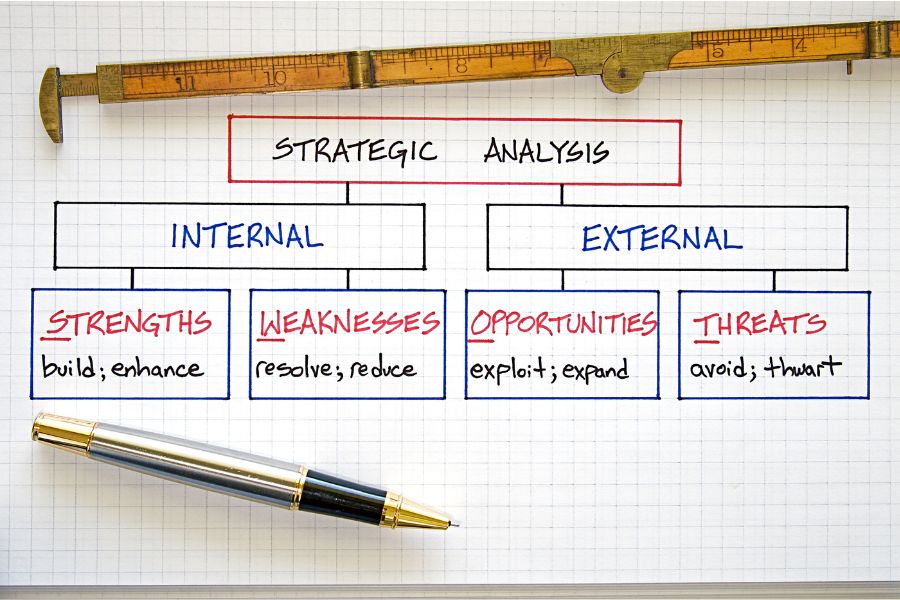"Competition is not only the basis of protection to the consumer but is the incentive to progress." — Herbert Hoover
This quote perfectly sums up the role of competition in the marketplace. Competition protects customers’ interests by continually driving businesses to improve and provide quality products.
However, knowing how to stand out and attract customers in a competitive market is a different matter. Like a game of chess, understanding your competitors requires foresight in planning your strategies. Analyzing and responding to your competitors' moves is essential for staying ahead.
The same concept applies to competitor analysis for market research. Competitive analysis lets you learn your competitors’ strengths, weaknesses, and strategies, helping you spot opportunities and plan a winning business strategy. In fact, 90% of Fortune 500 Companies leverage this approach to gain a competitive edge. Here's a quick guide on how to perform effective competitor analysis for market research.
What is Competitor Market Research?
Competitor market research is a strategic approach to understanding your rivals within the same industry. It involves gathering, analyzing, and interpreting information about competitors.
This type of research covers various aspects of their business model, such as their products, pricing, marketing strategies, and customer service.
However, it's not just about understanding what your competitors are doing but why they're doing it. For this reason, learning their business objectives, strengths, weaknesses, and overall market position is crucial.
Key areas that competitor research typically examines include:
- Product offerings and pricing strategies
- Sales tactics and customer service approach
- Online presence and SEO strategies
- Social media activity and content marketing efforts
- Brand positioning and market share
Steps to Conducting Market Research Competitor Analysis
1. Identify Your Competitors
Start by identifying and organizing all competitors within your industry for your competitive analysis. You can use Google search, industry reports, or dedicated service vendors to help you kickstart the process.
When you compile your list of competitors, classify them into four distinct categories:
- Direct competitors
Direct competitors provide comparable products or services to an identical target audience. Customers frequently evaluate between these brands when making a purchase. For instance, Amazon and eBay compete directly in the online marketplace sector.
- Legacy competitors
These companies have solidified their market position over decades of growth and brand development, making them formidable competitors in their respective industries. A prime example is The Walt Disney Company and Universal Pictures, veteran players in the entertainment and theme park domain.
- Emerging competitors
These are fresh contenders with distinctive business models, often disrupting established markets with offerings that are considerably different or better. For instance, TikTok quickly became a major player in social media with its short-form video content, challenging platforms like Facebook, Instagram, and YouTube.
- Indirect competitors
These businesses offer different solutions that tackle the same consumer pain point. This variety opens avenues for diversification and expansion because companies can discover new markets to help innovate their offerings and attract a broader range of customers. For example, coffee shops and tea houses both cater to people looking for beverages but offer different types of drinks.
Key Takeaway
Break down your competitors into direct, legacy, emerging, and indirect categories. This helps you see the bigger picture and strategize effectively against each type.
2. Gather Information
Now that you’ve identified your competitors, it’s time to examine each one in-depth and determine its strategies, strengths, and areas for differentiation. This holistic approach helps you uncover valuable insights to inform business decisions.
Mapping Market Positions: Visualize competitors based on their market presence and customer satisfaction to understand their strategic positions. This enables you to pinpoint specific competitors for a more detailed analysis.
- Leaders - Dominant industry players that combine large market shares with high customer satisfaction rates.
- High Performers - These are often emerging brands excelling in customer satisfaction despite a smaller market share.
- Contenders - These businesses have great brand visibility but lower customer satisfaction rates.
- Niche Players - Brands catering to smaller market segments but have high customer satisfaction rates.
Benchmarking Competitors: Conducting a detailed assessment across key areas of your competitors’ business gives you a comprehensive view of their overall performance and how they compare.
- Quality - Evaluate product features and customer feedback to understand what customers like and dislike about your competitors' offerings.
- Customer Service - Assess support channels and satisfaction ratings to determine how well competitors address customer issues. This helps pinpoint areas where your customer service can excel.
- Brand Reputation - Investigate brand perception through online reviews or social media mentions. This allows you to analyze critical feedback or praise that could position your brand more favorably.
- Financial Health - Review financial indicators such as revenue growth and profitability. This provides insight into their financial stability and capacity for future investments.
- Price - Analyzing pricing strategies and perceived customer value enables you to develop competitive pricing models that align with market expectations.
Analyzing Marketing Strategies: Explore competitors' approaches across various marketing channels to analyze their tactics. With this, you can adopt and adapt successful practices to enhance your marketing efforts.
- Website: Study competitor websites’ structure, user experience, and branding to understand how they communicate their products or services to visitors.
- Email Marketing: Understand the timing and engagement strategies of competitor email campaigns by subscribing to their newsletters.
- Paid Advertising: Using tools like Ahrefs and Semrush, you can analyze their paid advertising campaigns, including keywords, ad copy, and targeting.
- Thought Leadership: Assess their efforts in establishing industry leadership through educational content such as webinars and articles.
- Digital PR and Social Media: Evaluate the type of content they post, engagement rates, and PR efforts to understand how they interact with their audience and present themselves online.
- Partnerships: Review their collaborations with other companies to help you identify beneficial partnership opportunities.
Key Takeaway
Use tools like Google Analytics and SEMrush to dive deep into your competitors' products, pricing, marketing, and customer service. These insights will guide your strategic decisions and help you stay ahead.
3. Conduct a SWOT Analysis
A SWOT analysis is a powerful tool for maximizing your strengths (S), addressing weaknesses (W), capitalizing on opportunities (O), and mitigating threats (T).
With this approach, you can determine internal factors (strengths and weaknesses) that impact your business and external factors (opportunities and threats) that play a role in your market environment.
Strengths
Strengths are the internal attributes and resources that support a successful outcome. Consider what your business does well and what unique resources you possess. Knowing your strengths is crucial for developing strategies associated with your core competencies and capabilities.
Questions to ask:
- What does our business do well?
- What do customers praise us for?
- What are our unique advantages or assets?
Weaknesses
Weaknesses are internal factors that might hinder your success. Be honest about your business's limitations and identify potential risks that impede growth. Acknowledging weaknesses drives efforts to enhance your operations and products, leading to better performance.
Questions to ask:
- Where can our business improve?
- What internal factors are holding us back?
- What skills or resources are we lacking?

Opportunities
Opportunities are external factors that your business could use to its advantage. You can spot these by looking at market trends, technological advancements, and changes in consumer behavior.
By capitalizing on these opportunities, you can gain a strategic advantage over competitors by adapting to changing market conditions and consumer preferences – ensuring long-term sustainability for your business.
Questions to ask:
- What market trends can we capitalize on?
- Are there emerging markets we can enter?
- How can we leverage technology to improve our offerings?
Threats
Threats are external challenges that could negatively affect your business. These can include market competition, economic slumps, or shifting regulations. Recognizing and preparing for threats enables you to navigate crises and uncertainties more effectively.
Questions to ask:
- What economic or market changes could harm our business?
- Are there any new regulations that could affect us?
- What are our competitors doing that could impact us?
Tips for a Successful SWOT Analysis
- Internal Focus: Evaluate aspects under your control, like operations, marketing, and HR.
- External Focus: Examine factors outside your control, such as market trends, economic conditions, and competitor activities.
- Regular Reviews: Conduct quarterly reviews and brainstorm with your team to keep your analysis current and relevant.
- Action Plan: Develop action plans to address identified issues, prioritizing and allocating resources effectively.
- Ask Your Customers: Utilize qualitative research platforms to conduct interviews or focus groups with your target market to gather competitor feedback from a customer perspective.
4. Monitor Performance
Keeping tabs on your competitors is crucial for maintaining a market advantage. Regularly tracking competitor performance provides insights into their activities and positions within the industry. Here’s how you can do it effectively:
Leveraging Analytics
- Google Analytics: This tool can offer indirect insights into your competitors. For instance, tracking referral traffic sources can reveal potential partnerships or popular content strategies.
- Social Media Analytics: Platforms like Facebook, Twitter, and Instagram provide analytics tools that help you gauge competitors’ social media metrics, such as engagement levels and follower growth.
- Competitive Analysis Tools: Tools like SEMrush and Ahrefs allow you to track competitors' digital visibility and how much traffic they get.
Keeping Up with Industry Trends
- Trend Analysis: Regularly review industry reports or articles to identify emerging trends that can inform future strategies.
- Competitor Adaptation: Observing how competitors respond to these trends can reveal effective responses to market changes. You can learn effective strategies, avoid their mistakes, and refine your approach to maintain or gain a competitive advantage.
- Innovation Watch: Monitoring new products or services introduced by competitors highlights areas of innovation and market demand that can be used to inspire your research and development.
Key Takeaway
Perform a SWOT analysis to understand your strengths and weaknesses while spotting opportunities and threats. Keep an eye on your competitors and industry trends to stay flexible and continuously improve. You can also utilize qualitative restech services to gather customer feedback that could enhance your competitive analysis.
Mastering Competitor Analysis for Strategic Success
Competitor market research goes beyond data collection—it's a strategic imperative that helps you understand industry dynamics, identify growth opportunities, and adapt to market changes. By adopting a holistic approach to competitor analysis, you can refine your strategies based on actionable insights gleaned from competitors' successes and failures. This allows you to navigate challenges and capitalize on emerging opportunities effectively.
In addition, regular monitoring and analysis are crucial to maintaining agility in your industry. This ongoing process ensures you remain responsive to shifts in customer preferences, market trends, and competitor moves. Continuously improving your business processes through competitor analysis drives growth and ensures sustainability in the long run.
Understand Your Competitors with Civicom® Marketing Research Services
Civicom® Marketing Research Services is the global leader in providing web-enabled qualitative tools for market research. Our full-service solutions include online IDI and focus group facilitation, mobile research, online communities, respondent recruitment, an AI report writing tool, plus other customizable solutions for your research needs. Contact us to see how we can help you achieve project success.



